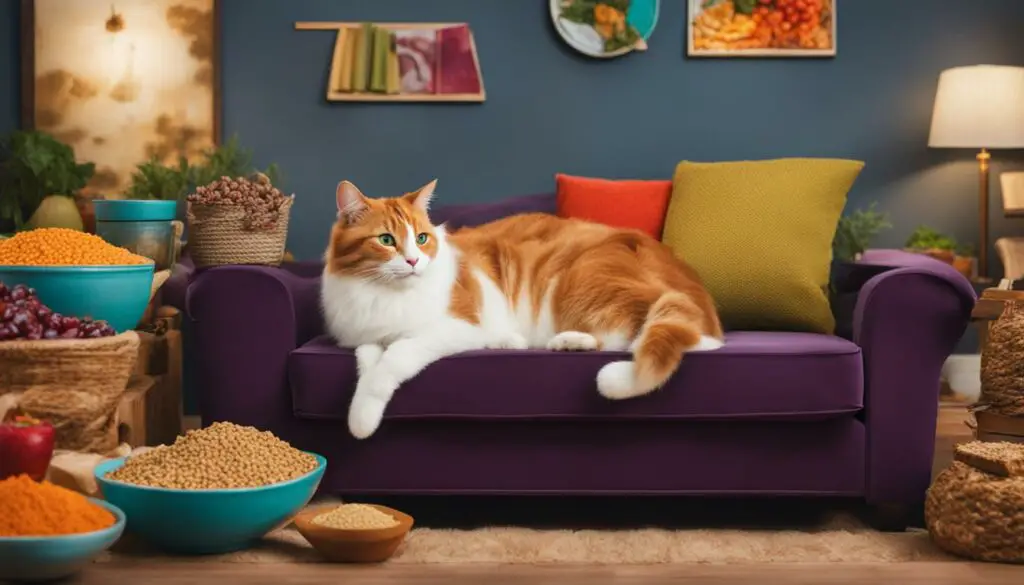When it comes to our feline friends, understanding their behavior and communication is crucial for building a strong bond. Cats have their own unique ways of expressing themselves, and one of the key ways they communicate is through body language cues. Whether it’s the position of their ears, the movement of their tail, or their vocalizations, cats have a rich repertoire of signals that convey their mood, emotions, and needs.
In this guide, I will walk you through the fascinating world of ‘cat MSG’ (Message Signaling in Cats) and help you decipher what your furry companion is trying to tell you. From understanding their body language to decoding their vocalizations, we’ll cover it all. So, let’s dive in and unravel the secrets of cat communication!
Key Takeaways:
- Understanding cat body language is essential for interpreting their mood and emotions.
- Cats use various vocalizations, such as purring and meowing, to communicate with humans.
- Cat body postures and tail movements can convey important messages about their intentions.
- Visual cues like eye and ear positions provide insights into a cat’s current state.
- By paying attention to these communication cues, you can better understand your cat’s needs and emotions.
How to Read a Cat’s Body Language
Cats have a unique way of communicating through their body language. Understanding their signals can help you better understand your feline friend’s mood and needs. Here are some key elements to look out for when reading a cat’s body language:
Ears:
The position of a cat’s ears can tell you a lot about how they are feeling. When a cat’s ears are relaxed and facing forward, it indicates that they are calm and content. However, if their ears are flattened or pointing backward, it suggests that they are scared or agitated.
Tail:
A cat’s tail also plays an important role in their communication. A relaxed cat will typically hold their tail low and straight. On the other hand, an arched or puffed-up tail indicates fear or aggression. A twitching tail can signify excitement or anticipation.
Body Posture:
Pay attention to how a cat carries themselves. A relaxed cat will have a loose and comfortable posture, with their body slightly lowered. If their body is tense and upright, it may indicate that they are on high alert or ready to defend themselves.
By observing these subtle cues, you can decipher your cat’s body language and respond accordingly. This will help you build a stronger bond with your feline companion and ensure their well-being.

Signs of a Playful Cat
When it comes to understanding our feline friends, recognizing the signs of a playful cat is essential. Play is an important aspect of a cat’s life, helping them exercise, relieve stress, and satisfy their natural instincts. By being able to identify the behaviors and cues that indicate playfulness, we can ensure that our cats are happy, engaged, and experiencing a fulfilling lifestyle.
Here are some common signs of a playful cat:
- Erect ears: A playful cat will often have their ears pointed upwards and forward, showing their attentiveness and excitement.
- Dilated pupils: When a cat is in a playful mood, their pupils may appear larger than usual, indicating their heightened level of focus and anticipation.
- Twitching or raised tail: A cat’s tail can act as a barometer of their emotions, and when a cat is feeling playful, their tail may twitch or wag in a rhythmic manner.
- Intense focus: A playful cat will be fixated on their target, whether it’s a toy, a moving object, or even your hand. They may exhibit a crouched posture, ready to pounce at any moment.
By recognizing these signs, we can provide the appropriate environment and stimulation for our playful cats. Engaging in interactive play sessions, providing toys that mimic prey, and setting up play areas in our homes can all contribute to a happy and content cat.
| Signs of a Playful Cat | Description |
|---|---|
| Erect ears | A cat’s ears will be pointed upwards and forward, indicating their attentiveness and excitement. |
| Dilated pupils | When a cat is feeling playful, their pupils may appear larger than usual, revealing their heightened focus and anticipation. |
| Twitching or raised tail | A playful cat’s tail may twitch or wag in a rhythmic manner, showcasing their excitement and readiness to engage in play. |
| Intense focus | Playful cats will exhibit a crouched posture and intense focus on their target, preparing for a pounce or chase. |
Why Play is Important for Cats
Play is not just a source of entertainment for cats; it serves several important purposes for their overall well-being. Engaging in play helps cats release pent-up energy, exercise their muscles, and maintain a healthy weight. It also provides mental stimulation, preventing boredom and promoting cognitive development. Additionally, play allows cats to practice hunting skills and instincts, providing a sense of fulfillment and accomplishment.
As responsible pet owners, it’s crucial to recognize and encourage our cats’ play behavior. By providing interactive toys, engaging in play sessions, and creating a stimulating environment, we can enhance their quality of life and strengthen the bond we share with our feline companions.
Play is an integral part of a cat’s nature, and by understanding their playful behaviors, we can ensure they have a fulfilling and enriched life. From their erect ears and dilated pupils to their twitching tails and intense focus, these playful signs allow us to engage with our cats in a meaningful way. So let’s embrace playtime and provide our furry friends with the stimulation and joy they deserve.
Identifying a Scared Cat
When a cat is scared or fearful, they exhibit specific body language cues that indicate their discomfort and desire to retreat. By recognizing these signs, you can create a safe and calming environment for your feline companion.
One of the most common signs of a scared cat is flicking ears. When a cat’s ears are rapidly moving back and forth, it signifies their heightened alertness and unease. Additionally, wide-open eyes with dilated pupils are another telltale indication of fear. Dilated pupils allow cats to take in more light, enhancing their ability to perceive potential threats in their surroundings.
A scared cat may also display an arched back, puffing up their fur in an attempt to appear larger and more intimidating to potential predators. This defensive posture is often accompanied by a raised or tucked tail, depending on the individual cat’s response to fear. Hissing and displaying teeth are defensive behaviors frequently observed in a scared cat, serving as a warning to others to stay away.
By being attentive to these body language cues, you can help alleviate your cat’s fear and provide them with the reassurance they need. Creating a secure and quiet space for your cat to retreat to can help them feel safe and reduce their anxiety levels.
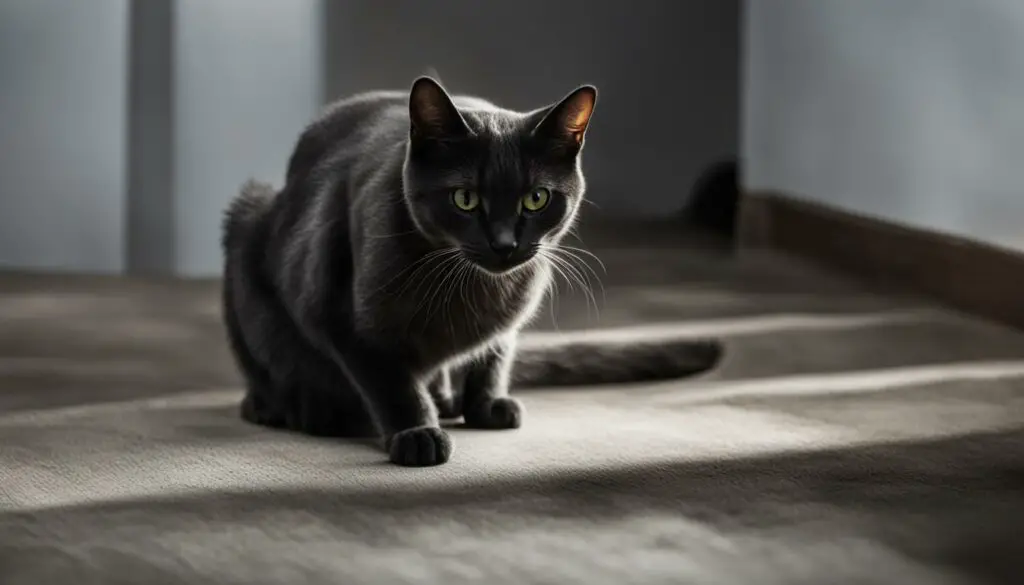
Common Signs of a Scared Cat:
- Flicking ears
- Wide-open eyes with dilated pupils
- Arched back
- Raised or tucked tail
- Hissing and displaying teeth
Other Ways Cats Communicate
In addition to body language and vocalizations, cats have other unique ways of communicating with humans and other animals. These behaviors provide valuable insights into their needs, emotions, and territorial boundaries.
1. Cat Scent Marking
Cats have scent glands located on various parts of their bodies, including their cheeks, chin, paws, and tail. They use these glands to leave their scent on objects and surfaces as a way of marking their territory. When a cat rubs against you or furniture, they are transferring their scent and claiming it as their own. Scent marking is a form of communication that signals to other cats that a particular area or object is already claimed. It’s their way of saying, “This is mine.”
2. Cat Kneading Behavior
Have you ever noticed your cat “kneading” on a soft surface, such as a blanket or your lap? Kneading is a common behavior in cats that starts as early as their days as kittens. They will rhythmically push their paws in and out against the surface while flexing their claws. This behavior is often associated with feelings of comfort, relaxation, and contentment. It is believed to be a throwback to their days as nursing kittens when they would knead their mother’s belly to stimulate milk flow.
While these are just a few examples of how cats communicate, it’s important to remember that each cat is unique and may have their own individual ways of expressing themselves. By paying attention to their behaviors and body language, you can deepen your bond with your feline companion and better understand their needs and emotions.
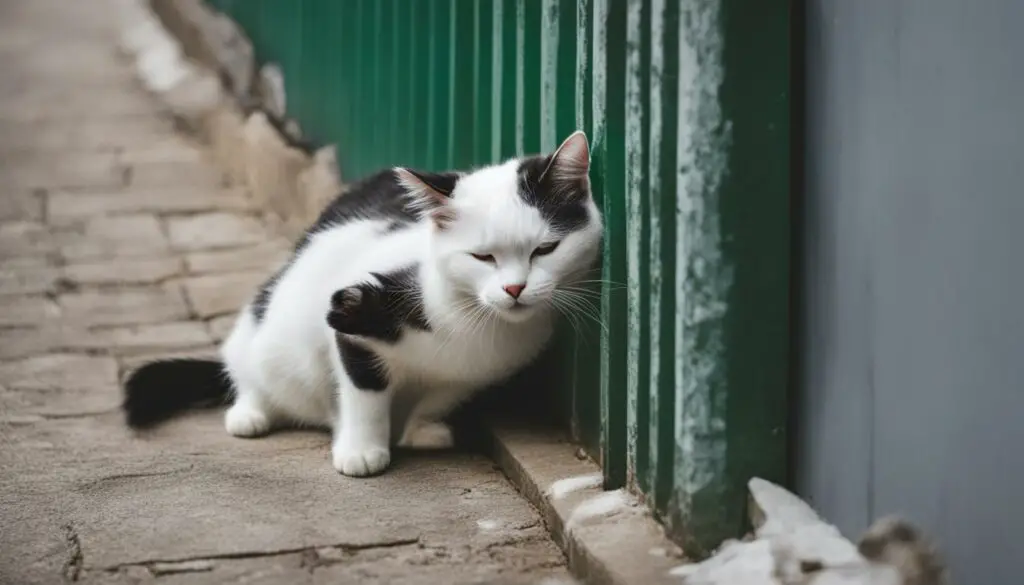
| Cat Communication Method | Description |
|---|---|
| Scent Marking | Cats use scent glands to leave their scent on objects and surfaces, marking their territory. |
| Kneading Behavior | Cats knead on soft surfaces as a sign of comfort and contentment. |
| Vocalizations | Cats use different sounds like meowing, purring, chirping, growling, and hissing to communicate their needs and emotions. |
Cat Vocalizations
One of the most fascinating aspects of cat communication is their vocalizations. Cats have a wide range of sounds they use to express their needs, feelings, and desires. Let’s take a closer look at some of the most common cat vocalizations:
Meowing
Meowing is a versatile vocalization that cats primarily use to communicate with humans. It can have different meanings depending on the situation and context. For example, a cat may use a short, soft meow to greet you or request attention. On the other hand, a long, loud meow may indicate hunger or a desire to go outside. It’s important to pay attention to your cat’s meows and understand their specific meaning based on the situation and your cat’s body language.
Purring
Purring is a unique sound that cats produce when they are content and relaxed. It’s a soothing and comforting sound that not only reassures the cat but also has a calming effect on humans. Cats may purr when they are being petted, cuddled, or feeling safe and content. However, it’s important to note that cats can also purr when they are in pain or stressed. Understanding the context and accompanying body language will help you determine whether your cat’s purring is a sign of contentment or something else.

The Science Behind Purring
As a cat owner, you’ve likely experienced the soothing sound of your feline friend’s purring. But have you ever wondered why cats purr and what the mechanism behind this unique vocalization is? Purring is a fascinating behavior that serves various purposes and has been the subject of scientific study.
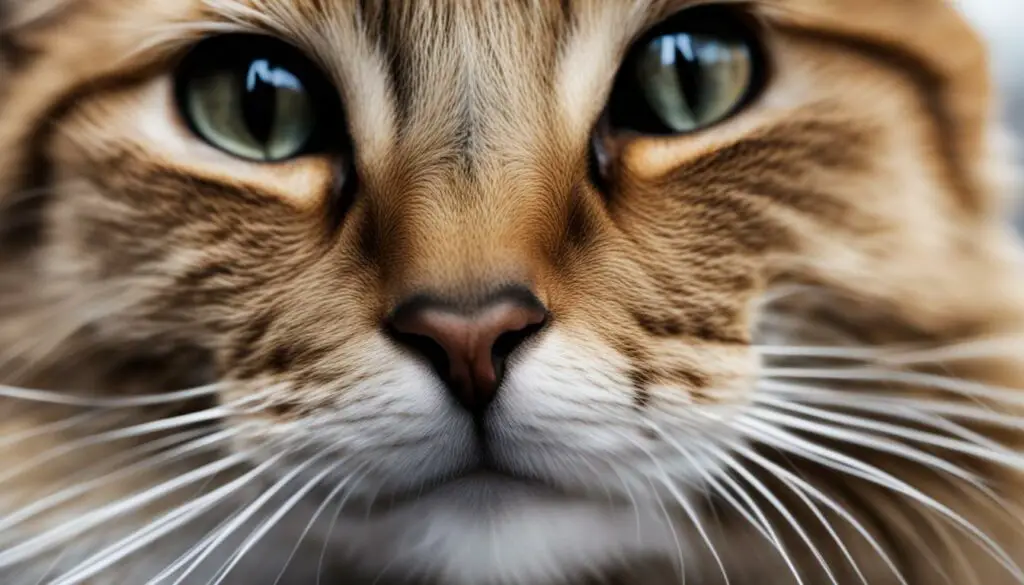
The exact mechanism behind purring is still not fully understood, but researchers believe it involves the rapid contraction and relaxation of the laryngeal muscles. This vibration of the vocal cords produces the rhythmic sound we associate with purring. Cats can control the frequency of their purring, ranging from 25 to 150 Hertz.
Purring is commonly associated with contentment, relaxation, and pleasure. Cats often purr when they are being petted, cuddled, or in the presence of their favorite humans. However, cats may also purr in other situations, such as when they are in pain, fearful, or stressed. This suggests that purring serves not only as a means of communication but also as a self-soothing mechanism for cats.
Benefits of Purring
The therapeutic effects of purring have been observed in both cats and humans. Studies have shown that the vibrations produced during purring have healing properties and can help promote relaxation, reduce stress and anxiety, lower blood pressure, and even aid in the healing of bones and tissues. Additionally, the frequency of a cat’s purr has been found to have a calming effect on humans, similar to the therapeutic benefits of meditation and gentle massages.
| Benefits of Purring | Explanation |
|---|---|
| Relaxation and stress reduction | The vibrations produced during purring can have a calming effect on both cats and humans, promoting relaxation and reducing stress. |
| Lower blood pressure | The rhythmic sound of purring has been shown to help lower blood pressure in both cats and humans, contributing to overall cardiovascular health. |
| Pain relief | Purring has been associated with pain relief in cats, as the vibrations may stimulate the release of endorphins, natural painkillers in the body. |
| Healing properties | The vibrations produced by purring have been found to aid in the healing of bones, tissues, and wounds, potentially speeding up the recovery process. |
While the science behind purring is still not fully understood, its benefits for both cats and humans are undeniable. So, the next time you hear your furry companion purring, take a moment to appreciate the complex mechanism behind this soothing sound and the positive effects it can have on your well-being.
The Sounds of Meowing
Meowing is a common vocalization used by cats to communicate with humans, and it can have different meanings depending on the situation. Understanding your cat’s meowing behavior and the meaning behind it is essential for effective communication and meeting their needs.
When your cat meows, it is their way of getting your attention. It can be a request for food, water, or simply wanting some affection and playtime. Kittens especially use meowing to communicate with their mother, but as they grow older, they tend to meow less frequently to other cats.
The tone and intensity of your cat’s meow can also provide valuable insights into their emotional state. A soft and friendly meow generally indicates contentment and a desire for interaction, while a loud and demanding meow may suggest frustration or urgency.
To better understand what your cat is trying to communicate through their meows, pay attention to the context and accompanying body language. Observe if they are rubbing against your leg, leading you to their empty food bowl, or exhibiting other signs of discomfort or distress. This will help you decipher the meaning behind their meows and respond appropriately to their needs.
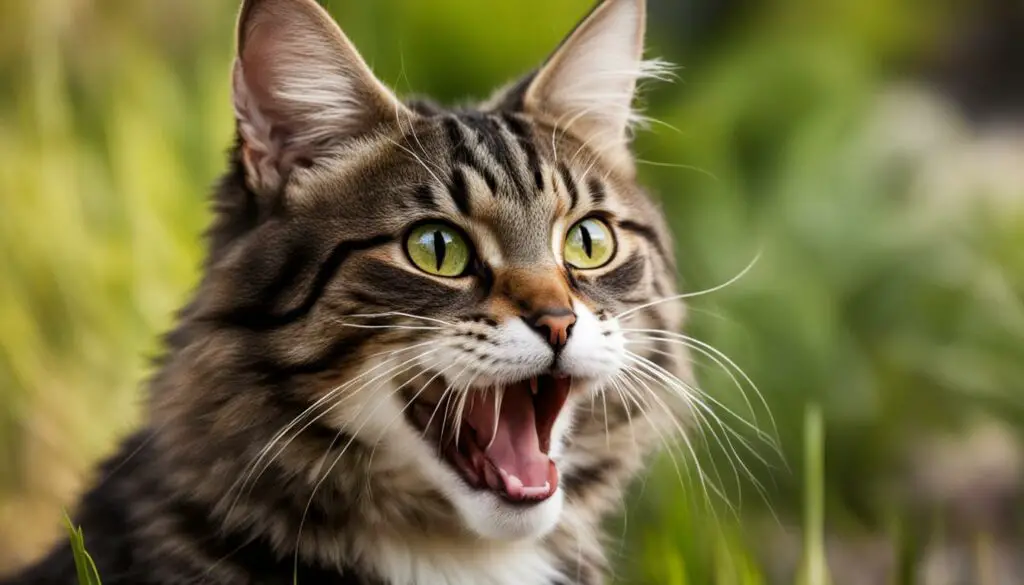
Common Reasons for Cat Meowing:
- Requesting food, water, or treats
- Seeking attention and playtime
- Expressing discomfort or pain
- Feeling lonely or bored
- Signaling stress or anxiety
“Understanding your cat’s meowing behavior and the meaning behind it is essential for effective communication and meeting their needs.”
| Meow Type | Meaning |
|---|---|
| Short, high-pitched meow | Greeting or excitement |
| Long, drawn-out meow | Demanding attention or expressing need |
| Multiple rapid meows | Urgency or hunger |
| Low, growling meow | Aggression or discomfort |
Other Cat Vocalizations
While meowing and purring are the most commonly known vocalizations of cats, they also use other sounds to communicate. Let’s explore some of these unique vocalizations:
Chirping
Chirping is a high-pitched sound that cats make, resembling the chirping of a bird. This vocalization is often used by mother cats to communicate with their kittens. Additionally, friendly and sociable cats may also chirp to signal their approachability and invite interaction. It’s an adorable sound that shows their playful and friendly nature.
Growling
Growling is a low, rumbling sound that cats make when they feel threatened or scared. It is a defensive vocalization that often accompanies aggressive body language, such as arched back, flattened ears, and bared teeth. A growling cat is warning you to keep your distance and avoid any potential conflict.
Hissing
Hissing is a sharp, hissing sound that cats produce by forcing air through their vocal cords. It is a clear sign of aggression and fear. When a cat hisses, they are signaling that they feel threatened and are ready to defend themselves if necessary. Hissing is often accompanied by an arched back, puffed-up fur, and bared teeth. It’s important to give a hissing cat space and allow them to calm down on their own terms.
These vocalizations, along with body language cues, help cats communicate their emotions, intentions, and boundaries. By understanding these vocalizations, you can better interpret your cat’s needs and respond accordingly.
| Vocalization | Meaning |
|---|---|
| Chirping | Friendliness, playfulness |
| Growling | Threat, aggression, fear |
| Hissing | Aggression, fear, defense |
Understanding these vocalizations can deepen your connection with your feline companion and create a harmonious environment for both of you. Paying attention to their sounds and body language will enable you to respond appropriately and provide the care and support your cat needs.
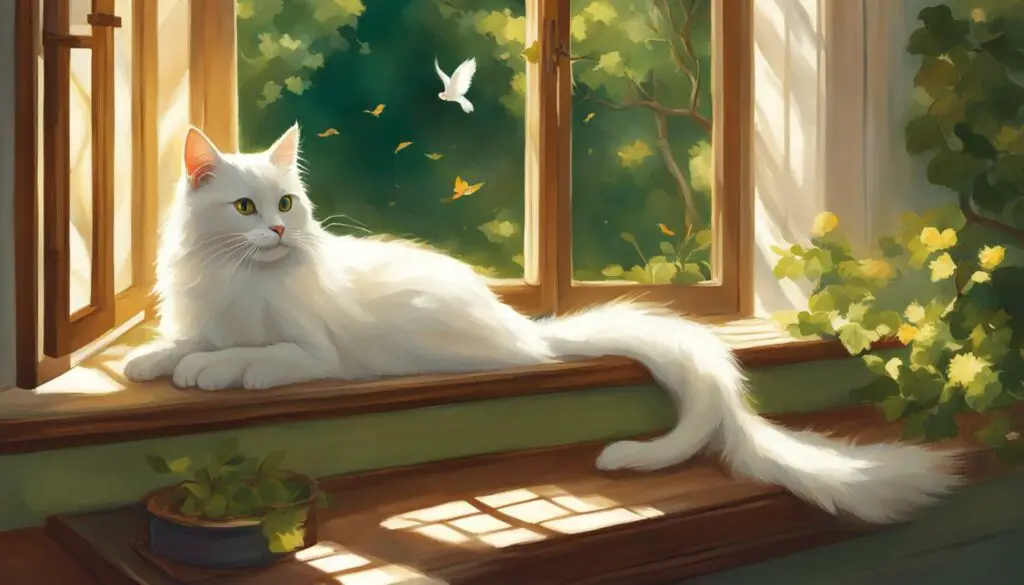
Cat Visual Communication: Decoding Body Postures
When it comes to understanding our feline friends, visual communication cues play a vital role. Cats have a unique way of expressing their emotions and intentions through their body postures. By paying attention to these visual cues, we can gain a deeper understanding of what our cats are trying to communicate.
Cat body postures can range from relaxed and content to defensive and fearful. For example, an upright and confident stance with ears forward and tail held high indicates a cat that is feeling alert and interested in their surroundings. On the other hand, a crouched posture with ears flattened, tail tucked, and body low to the ground suggests a cat that is experiencing fear or aggression.
Observing a cat’s body postures in combination with other visual cues, such as tail movements and eye expressions, can provide valuable insights into their current state of mind. By understanding these body postures, we can create a safe and comfortable environment for our cats and respond appropriately to their needs.
| Body Posture | Meaning |
|---|---|
| Upright stance with erect ears | Alert and interested |
| Crouched posture with flattened ears | Fear or aggression |
| Arching back with raised hairs | Threat display |
| Relaxed posture with tail held low | Content and at ease |
Remember, every cat is unique, and their body language may vary slightly. It’s essential to familiarize yourself with your own cat’s individual communication style and take note of any consistent patterns in their body postures. This will help you build a stronger bond with your feline companion and respond to their needs effectively.
Postures and Their Meanings
Understanding a cat’s postures can provide valuable insights into their current state and intentions. Cats use their bodies to communicate a wide range of emotions, from relaxation to defensiveness. By observing their postures, along with other visual cues like tail movements and ear positions, you can decipher your cat’s communication signals. Here are some common cat postures and their meanings:
1. Crouching
When a cat is crouching low to the ground with their body tense, it typically indicates that they are in a defensive or fearful state. They may be preparing to pounce or protect themselves from a perceived threat. It’s important to approach a cat in this posture with caution and give them space to feel safe.
2. Stretching
When a cat stretches, extending their body and limbs while keeping their tail upward, it signifies a state of relaxation and contentment. Stretching is a common behavior for cats after a nap or when they feel comfortable and secure in their environment.
3. Lying on Their Side
When a cat lies on their side with their belly exposed, it indicates trust and vulnerability. This posture is a sign of relaxation and comfort, demonstrating that the cat feels safe in their surroundings and with the people around them.
Remember that each cat is unique, and their postures may vary slightly. It’s essential to observe your cat’s individual behavior and consider the context when interpreting their postures. By paying attention to these visual cues, you can build a stronger bond with your feline friend and better understand their needs and emotions.
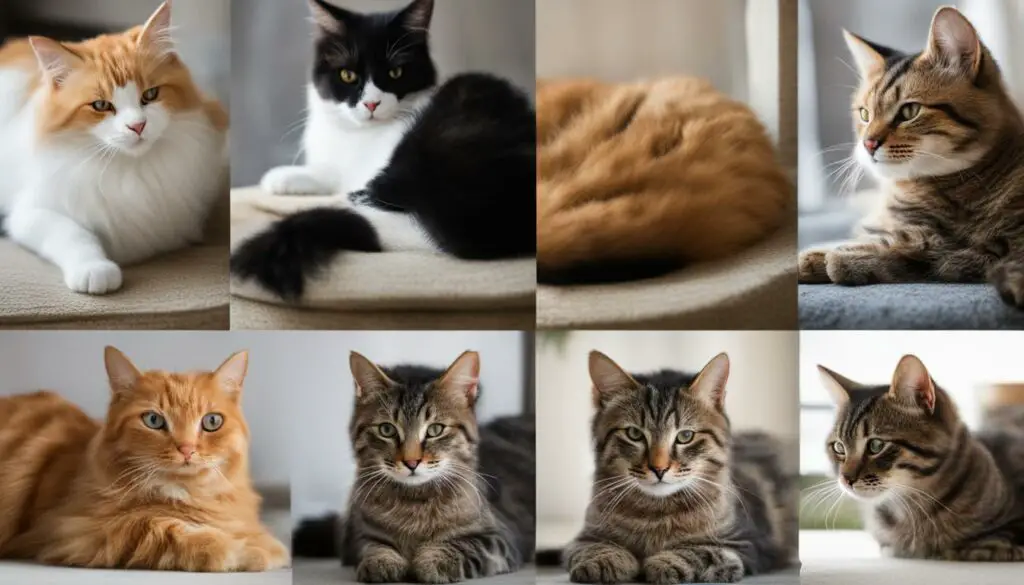
Reading a Cat’s Eyes and Ears
Cats have a unique way of communicating their emotions and intentions through their eyes and ears. By paying attention to their visual cues, you can better understand what your feline friend is trying to convey.
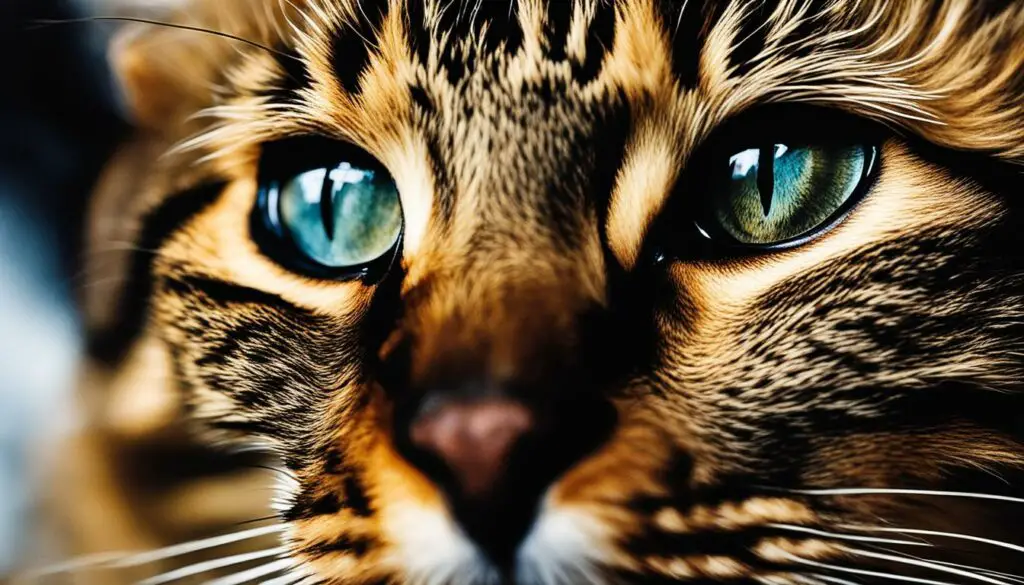
Cat Eyes: A cat’s eyes are a window into their emotions. Wide-open eyes with dilated pupils can indicate fear or excitement, while partially closed eyes are a sign of relaxation and trust. Observe the size of their pupils, as larger pupils can suggest heightened emotions or arousal. However, it’s important to remember that pupil size can also vary based on lighting conditions.
Cat Ears: The position of a cat’s ears can provide valuable information about their mood. Erect ears indicate alertness and interest, while flattened or backward-facing ears can reveal fear or aggression. Pay attention to any changes in ear position and consider the context to better understand what your cat is expressing.
When trying to interpret a cat’s eyes and ears, it’s crucial to consider their overall body language and the specific situation. Different combinations of eye and ear positions, along with other gestures, provide a more accurate understanding of your cat’s communication signals.
The Role of Tail Movements
When it comes to understanding cat communication, tail movements play a significant role. A cat’s tail can convey a range of emotions and intentions, providing valuable insights into their current state of mind. By paying attention to their tail behavior, you can better understand what your cat is trying to communicate.
Here are some common tail movements and their meanings:
- Straight and low: A relaxed and content cat will typically hold their tail low and still. This signals a sense of calmness and comfort.
- Twitching: A twitching tail can indicate excitement or anticipation. You may observe this behavior when your cat is focused on something, such as a prey or a toy.
- Puffed-up: When a cat’s tail is puffed up, it usually signals fear or aggression. They may be feeling threatened or anxious in their environment.
It’s important to remember that tail movements should be observed in conjunction with other body language cues to get a complete understanding of your cat’s emotions. Factors such as their overall posture, ear positions, and vocalizations can provide additional context.
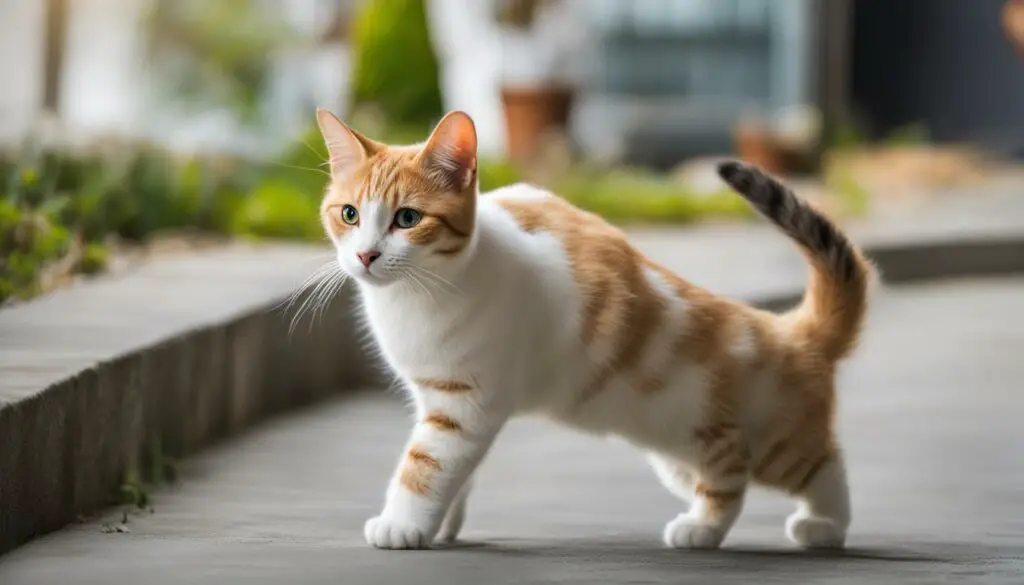
| Tail Movement | Meaning |
|---|---|
| Straight and low | Relaxation and contentment |
| Twitching | Excitement or anticipation |
| Puffed-up | Fear or aggression |
“A cat’s tail can provide valuable insights into their emotions and intentions. By observing their tail movements, you can better understand their current state of mind.”
Interpreting Tail Movements in Context
While tail movements can offer essential clues about a cat’s emotions, it’s crucial to consider the overall context and their individual behavior. A flicking tail, for example, can indicate annoyance or agitation if accompanied by flattened ears or dilated pupils. On the other hand, a gently wagging tail can signal a friendly and relaxed mood. It’s essential to observe a combination of body language cues to accurately interpret your cat’s communication signals.
Additionally, tail movements can vary between cat breeds and individuals. Some cats naturally have poofier tails, while others may have shorter or more slender tails. Take the time to familiarize yourself with your cat’s unique tail characteristics and how they correspond to their emotions. This personal understanding will go a long way in strengthening your bond and communication with your feline companion.
Conclusion
Understanding cat behavior and communication is crucial for fostering a strong connection with your feline companion. By paying attention to their body language, vocalizations, and visual cues, you can gain valuable insights into their needs and emotions. This comprehensive guide serves as a valuable resource for cat owners looking to enhance their understanding of their furry friends.
Remember, each cat is unique, so it’s important to observe and interpret your cat’s individual behavior. If you have any concerns about their health or behavior, it’s always best to consult with a veterinarian who can provide professional guidance.
By becoming familiar with the various ways cats communicate, such as through body language, vocalizations, and visual cues, you can create a harmonious environment that meets your cat’s needs. Building a strong bond with your feline friend is not only rewarding but also essential for their overall well-being. So, embrace the opportunity to decode your cat’s messages and deepen your understanding of their fascinating world.
FAQ
How can I understand my cat’s body language?
You can understand your cat’s body language by observing their tail, ears, eyes, and body posture. These cues can indicate their mood and emotions, such as relaxation, playfulness, fear, and illness.
What are the signs of a playful cat?
Signs of a playful cat include energetic behavior, stalking, chasing, pouncing, erect ears, dilated pupils, intense focus, and twitching or raised tail.
How can I identify if my cat is scared?
You can identify a scared cat by observing cues such as flicking ears, wide-open eyes with dilated pupils, an arched back, raised or tucked tail, hiding, hissing, and displaying teeth.
How do cats communicate in ways other than body language?
Cats communicate through methods like rubbing against objects to mark their territory, kneading to show comfort, and using vocalizations like purring, meowing, chirping, growling, hissing, and howling.
What does purring mean in cats?
Purring is commonly associated with contentment, but cats may also purr when they are in pain or experiencing stress. The frequency of a cat’s purr can have therapeutic effects, promoting relaxation and healing.
What does meowing signify in cats?
Meowing is a vocalization primarily used by cats to communicate with humans. It can signify attention-seeking, hunger, or a desire for interaction. The tone and intensity of meowing can vary.
What are some other vocalizations used by cats?
Cats also use vocalizations such as chirping, growling, hissing, and spitting. These vocalizations are typically used in defensive situations when a cat feels threatened or scared.
How can I interpret a cat’s visual communication cues?
Cats use facial expressions, body postures, eyes, ears, mouths, tails, and coat to convey various emotions and intentions. For example, an arched back and erect hairs can indicate a threatening stance.
What do different cat postures mean?
Different postures such as crouching, stretching, or lying on their side can indicate relaxation, playfulness, or a defensive stance in cats.
How can I read a cat’s eyes and ears?
Wide-open eyes with dilated pupils can indicate fear or excitement, while partially closed eyes signify relaxation and trust. The position of the ears can also provide valuable information about a cat’s mood.
What is the role of tail movements in cat communication?
Tail movements can convey important messages about a cat’s mood and intentions. A relaxed and happy cat will typically hold their tail low, straight, and still. Twitching or puffed-up tails may signify excitement, fear, or aggression.
How can I enhance my understanding of cat behavior?
Understanding cat communication cues and body language is essential for building a strong bond with your cat. By observing their behavior and consulting with a veterinarian when needed, you can ensure their well-being.
Source Links
- https://www.webmd.com/pets/cats/features/cat-body-language
- https://www.purina.co.uk/articles/cats/behaviour/understanding-cats/cat-body-language
- https://en.wikipedia.org/wiki/Cat_communication

